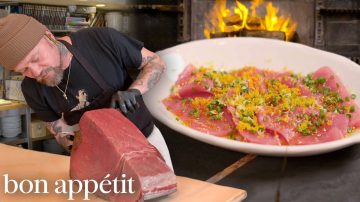The Best Beef Noodle Soup in Taiwan
Recipe Overview
Overview
The journey into the world of Taiwanese Beef Noodle Soup is a delightful exploration of flavors and textures. This dish begins with a rich broth made from a combination of chicken and beef bones, simmered to perfection. The addition of aromatics like ginger and scallions elevates the flavor profile, creating a fragrant base that is both savory and slightly sweet.
One of the standout features of this recipe is the use of beef shank, a cut that is revered in Taiwanese cuisine for its tender texture and rich flavor. The careful cooking process ensures that the meat remains juicy and flavorful, while the noodles provide a satisfying bite. The choice of noodles, whether thick or thin, adds another layer of texture to the dish, making each bowl a unique experience.
As the soup simmers, the chef emphasizes the importance of patience and attention to detail. Caramelizing the onions and carefully balancing the flavors with different types of bean paste and sugars creates a broth that is complex and deeply satisfying. The final touch of fresh scallions and cilantro adds brightness, making this dish not only comforting but also refreshing.
This Beef Noodle Soup is perfect for late-night cravings or a cozy dinner with friends. It embodies the essence of Taiwanese street food, showcasing the rich culinary traditions of the region while inviting you to savor every spoonful.
Recipe Details
Steps & Tips
Prep the base liquid for the broth using chicken, beef bone, and a little bit of offal.
Melt a little bit of beef tallow in a pan and bring it up to temperature.
Add ginger to the melted beef tallow to extract flavor.
Add scallions to the beef tallow for flavor extraction.
Tip: It's important to have both water and oil in beef noodle soup for flavor extraction.
Tip: Caramelizing onions takes time and patience; don't rush it for better flavor.
Sauté seasonings in the same wok with more fat, keeping the onion flavor.
Tip: Constantly agitate the bean paste in the wok to prevent it from sticking and burning.
Add soy sauce to the mixture and cook it down with the bean paste.
Pour the entire vat of seasoning into the broth to create the base for beef noodle soup.
Add rice wine and skinless poached tomatoes to the broth.
Tip: Peel tomatoes after poaching to avoid bitterness in the broth.
Add large beef cheeks to the broth and cook for 30 minutes.
Follow with beef shanks and smaller beef cheeks for 20 minutes.
Finally, add riblets to the broth for about 10 minutes.
Let the beef rest for another hour after cooking.
Tip: Beef should be tender but not overly so; it needs to have structural integrity.
Tip: Using a noodle cooker that refreshes the pasta water prevents noodles from becoming soggy.
Cook the noodles for about 2 minutes in the noodle cooker.
Plate the noodles and top with beef shank, cheek, and rib.
Ladle the broth over the plated noodles and beef.
Garnish with scallions and cilantro.
Tip: Incorporate spicy beef tallow into the broth for added flavor.
Ingredients
Nutrition
Skill Level
Frequently asked questions
Below you will find answers to the most common questions about this recipe.
Got a Recipe Question? Ask Away!
Interesting Tidbits
- •Beef shank is a prized cut in Taiwan, known for its even distribution of fat and collagen.
- •The broth is made from a combination of chicken, beef bones, and aromatics for a rich flavor.
- •Using peeled tomatoes in the broth prevents bitterness from the skin.
- •The dish is traditionally served with thick wheat noodles and garnished with scallions.
















